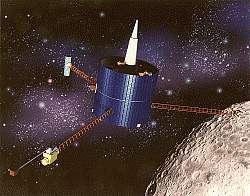Expectations were high, but ultimately no water was discovered through the crash

A year ago, the "Lunar Prospector" spacecraft made a discovery that shocked the scientific community: measurements made by the spacecraft indicated signs of frozen water at the north and south poles of the moon. At noon on Saturday according to Israel time, the prospector performed its last mission and crashed on the south pole of the moon in order to find unequivocal proof of the existence of water on the moon. Until the time of publishing the news, scientific findings from this crash landing have not yet arrived.
The frozen water, NASA believes, is hidden deep in underground pockets in the craters, in places that are always elevated due to the crater walls. NASA estimates that millions of tons of frozen water are buried there. If this estimate turns out to be correct, then there is enough water there to support the wizard's idea of establishing human colonies on the surface of the moon. If water is indeed found on the south pole of the moon, it will become "the most valuable piece of real estate in the solar system," said one NASA scientist.
Finding ice on the moon can also significantly reduce the cost of establishing permanent research stations on the moon. "If there is water there, you can close off areas for growing plants, growing your own foods and producing fuel and air," says Antony Cook, one of the scientists who work with NASA, "we won't have to launch all these things in large rockets from Earth."
How did the water even get to the moon? According to the prevailing hypothesis, space bodies such as water-rich comets have hit the surface of the moon in the past. According to this hypothesis, water from these bodies was absorbed into the lunar soil and stored in dark regions at the lunar poles.
If all went according to plan, the crash of the spacecraft on the surface of the moon released a cloud of water vapor into space. A battery of powerful telescopes - on Earth and in space - is aimed at the site of the explosion. With the help of these telescopes it is possible to detect water vapor or its by-product, hydroxyl.
But some scientists think that the chances of there being water on the moon are slim, and there are also those who doubt the chances of success of the crash to prove its existence. The skeptics point out that what the prospector actually found in the past was hydrogen, and that there is no guarantee that the hydrogen atoms on the moon actually indicate the presence of water.
Two scientists from Stanford University, Von Eschelman and George Parks, argued in a letter published in the scientific journal "Science" that there is a greater probability that the spacecraft will collide with concrete-like minerals than lunar ice. If there is water on the moon, claims Eshlman, it is most likely in the form of some type of crystalline minerals containing water molecules, but the bonds between them are very tight and a very high temperature is needed to break these bonds and extract usable water from them.
The energy that will be released in the crash, says Eshlman, will be able to vaporize frozen water - if it exists - but not break up the crystals. The crash will provide "at best, ambiguous results," writes Eshlman, "that is, it may show the desired signs of the presence of water, even if there is no free water on the moon."
